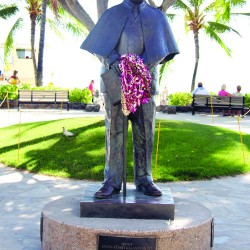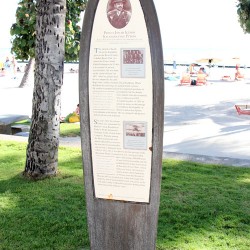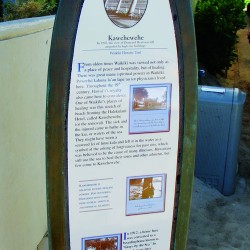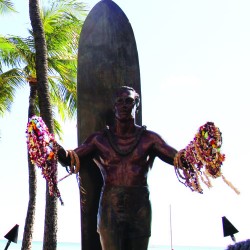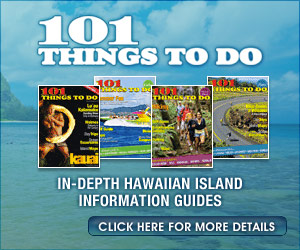Tracking Time
Get some exercise along the Waikiki Historic Trail.
One of the problems many travelers have while on vacation is finding the time to fit in exercise while still getting to tour all the historic sites their destination has to offer. Why not kill two birds with one stone and experience the hidden history of Waikiki along a scenic running path?
Running is an ideal form of exercise for many reasons. Not only is it an excellent form of cardio to get your heart pumping—studies show 30 minutes of physical activity a day will reduce your risk of heart disease, diabetes and other chronic health conditions—but running, jogging or even walking in the outdoors offers you the chance to immerse yourself in the beauty and culture of Hawai’i first-hand.
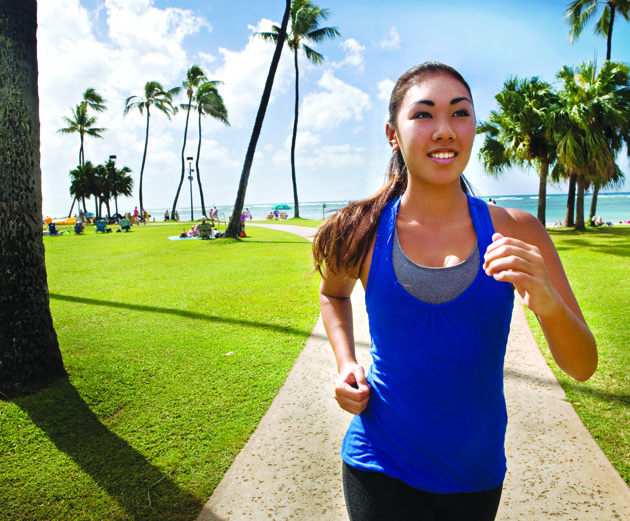
The Waikiki Improvement Association, a private nonprofit dedicated to keeping Waikiki a paradise for both locals and tourists, and author/historian Dr. George Kanahele designed the Waikiki Historic Trail to help tell the “untold” stories of this travel hot-spot. Nineteen bronze surfboards mark the spots where many important events took place, while some structures serve as markers themselves; note there are 23 sites total dotting the two-mile route in Waikiki.
Starting from Kapi’olani Park, take this route below to get an exciting introduction to Hawaiian history.
Want more? Visit www.waikikihistorictrail.com for additional sites to add to this running path or to make your own.
And don’t forget the sunscreen.
1. KAPI’OLANI PARK/WAIKIKI BEACH (MARKER 1)
Dedicated in 1877 by King David Kalakaua in honor of his wife, Queen Kapi’olani, the park’s main feature once was a horse-race track. Today it is a place of recreation for both residents and visitors.
In ancient times, at least two heiau (temples) were located near the shoreline in this area. Kupalaha, located at Queen’s Surf Beach, may have functioned in connection with the famed Papa’ena’ena heiau, where it is believed the last human sacrifice was made by Kamehameha I. The other, Makahuna, found near the foot of Diamond Head, was dedicated to Kanaloa, the god of the ocean.
Located nearby are other historic sites, including the Sans Souci hotel, which hosted famed Scottish writer Robert Louis Stevenson for five weeks in 1893; the War Memorial Natatorium, a monument dedicated to 179 island men who lost their lives in World War I; and the Outrigger Canoe Club, which was founded in 1908 to revive the Hawaiian ocean sports of surfing and canoe paddling.
2. KUHIO BEACH (MARKERS 4, 5 AND 6)
This long stretch of beachway (it runs from the Kapahulu Groin to the Beach Center) is named for Prince Jonah Kuhio Kalaniana’ole, Hawai’i’s second delegate to the United States Congress who served from 1902 to 1922. He is perhaps best known for passing the Homes Commission Act, which provided Native Hawaiians 200,000 acres of land for homesteading.
- Kuhio Beach Marker
- Kuhio Beach Marker
Prince Cupid, as he is popularly referred, lived in a stately home called Pualeilani, or “Flower From the Wreath of Heaven,” which once was located across the street from this marker. Upon his death, the property, including the beach, was given to the city of Honolulu.
Along Kuhio Beach you’ll come across other important sites that include the oft lei-draped Duke Kahanamoku statue, as well as the perplexing “wizard” stones of Kapaemahu.
3. THE BACK LAWN AT THE ROYAL HAWAIIAN (MARKER 12)
“The Pink Palace” truly is a sight to behold. With 400 lavishly decorated rooms and architecture modeled after the Spanish-Moorish style, The Royal Hawaiian was touted as the “finest resort hostelry in America” when it was completed in 1927.
But before these lands were home to a hotel, the area once was a royal coconut grove known as Helumoa. According to legend, the great chief Kakuhihewa planted the first tree in the 16th century and at one point, the grove consisted of nearly 10,000 trees!
Later, Kamehameha I camped here with his generals as they began their conquest of O’ahu. After uniting the islands and declaring Waikiki the first capital of the Kingdom of Hawai’i, Kamehameha built a Western-style stone house on this spot that often was occupied by his favorite wife, Ka’ahumanu, and her retainers.
4. GRAY’S BEACH (NEXT TO OUTRIGGER REEF HOTEL) (MARKER 13)
Did you know that in ancient times, Waikiki was not known as a place of fun, surf and recreation but rather as a place of healing? Hawaiians believed that people, places and things could possess a powerful spiritual force called mana. This stretch of beach was one such place where the sick or injured gathered to bathe in the ocean. Sometimes they would wear a lei of limu kala (seaweed) and leave it in the water as a way to ask for forgiveness of past sins, often believed to be the cause of their illness.
- Duke Statue (No Surfboard Marker)
- Duke Statue (No Surfboard Marker)
Once known as Kawehewehe (the removal), this beach has been home to kahuna la’au lapa’au (physicians), royalty and even a boardinghouse known as Grays-by-the-Sea. It is one of the best swimming areas on this side of O’ahu.
5. PAOA PARK (LOCATED NEAR FORT DERUSSY BEACH PARK) (MARKER 16)
This spot and much of the 20 acres now occupied by the Hilton Hawaiian Village once was owned by Duke Kahanamoku’s mother’s family, the Paoas. Duke’s grandfather, Ho’olae Paoa, was a descendent of royalty and received the land from King Kamehameha II as part of the Great Mahele of 1848.
Fast-forward some 60 years and Paoa’s grandson helped to make the sport of surfing a world-renowned event and won accolades as an Olympic swimming champ. It is at this location that the world-record-breaking Duke learned to swim the old-fashioned way—by being thrown into the water!—as well as where he learned how to surf and paddle an outrigger canoe.
Find more at www.waikikihistorictrail.com




